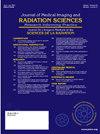The Role of Preparatory Mobile App Breath-Hold Coaching for Left-Sided Breast Radiotherapy in Patient Preparedness and Anxiety
IF 2
Q3 RADIOLOGY, NUCLEAR MEDICINE & MEDICAL IMAGING
Journal of Medical Imaging and Radiation Sciences
Pub Date : 2025-05-01
DOI:10.1016/j.jmir.2025.101937
引用次数: 0
Abstract
Purpose/Aim
Deep Inspiration Breath Hold (DIBH) technique is standard of practice for treating left-sided breast cancers as it reduces cardiac dose and limits late cardiac toxicities. The success of DIBH depends on patients’ ability to hold their breath, which may not be intuitive. Recent studies suggest that DIBH technique provokes patient anxiety which can interfere with breath-hold performance. Preparatory training for DIBH has been shown to reduce patient anxiety, however no research has explored preparatory DIBH training via mobile device apps. The aim of this study was to determine whether preparatory DIBH training with a mobile app improved anxiety and preparedness for breath-hold at CT simulation.
Methods/Process
This prospective parallel study consisted of two groups. The control group received the standard DIBH information sheet as education at time of radiation oncology consult, while the experimental cohort received the information sheet with additional breath-hold practice instructions using an app. In the experimental group, CT simulation was booked to occur no earlier than one week after consult so there could be time to practice with the app. Upon completion of the CT simulation appointment, both groups completed a short questionnaire. Survey results were compiled and analyzed using Fischer's Exact test and nonparametric Mann-Whitney tests.
Results or Benefits/Challenges
A total of fifty participants were recruited to the study, with twenty-five participants in each group. There were no significant differences in age (p=0.65), education level p=0.085), or anxiety prior to the CT simulation appointment (p=0.75), measured using a distress thermometer tool, between the two groups. Both groups felt the education they received prior to simulation was adequate, with 92% in the control group and 95.5% in the app group indicating they were very satisfied or satisfied. And both groups felt similar levels of confidence about holding their breath during their simulation, with 88% and 90.9% in the control and experimental groups, respectively, feeling very confident or confident. However, the proportion who felt prepared or somewhat prepared for their simulation appointment was higher in the experimental group (95.4%) compared to the control group (84%), and this difference was significant (p=0.042). For those patients in the experimental group, 77.3% found the app easy to use and 86.4% felt it helped with preparation for simulation. The same proportion (86.4%) felt that it reduced their anxiety level.
Conclusions/Impact
Preparatory DIBH training with a mobile device app did not have a statistically significant effect on patient anxiety or confidence of performing breath-holds during CT simulation. Patients in the experimental cohort did feel significantly better prepared for their simulation appointment and most found the app very easy to use. Our evidence suggests preparatory mobile training could be an effective tool to prepare patients for breath-hold, but the one week minimum between consult and simulation in the app-coaching group may be a confounding factor that needs to be further investigated. Usage of the app for pre-simulation education appears to have no negative effects and does not increase patient anxiety in any way.
左侧乳房放疗前手机应用屏气指导在患者准备和焦虑中的作用
目的/目的深度吸气屏气(DIBH)技术是治疗左侧乳腺癌的标准做法,因为它减少了心脏剂量并限制了晚期心脏毒性。DIBH的成功取决于病人屏住呼吸的能力,这可能不是直觉。最近的研究表明,DIBH技术会引起患者的焦虑,从而干扰屏气的表现。DIBH的预备训练已被证明可以减少患者的焦虑,但是没有研究探索通过移动设备应用程序进行DIBH预备训练。本研究的目的是确定使用移动应用程序的预备DIBH训练是否可以改善CT模拟时的焦虑和屏气准备。方法/过程本前瞻性平行研究分为两组。对照组在放射肿瘤学会诊时接受标准DIBH信息表作为教育,而实验组则接受信息表,并使用应用程序进行额外的屏气练习指导。在实验组中,CT模拟被安排在会诊后不早于一周进行,以便有时间使用应用程序进行练习。在完成CT模拟预约后,两组都完成了一份简短的问卷调查。调查结果汇编和分析使用菲舍尔的确切检验和非参数曼-惠特尼检验。结果或益处/挑战研究共招募了50名参与者,每组25名参与者。两组患者在年龄(p=0.65)、受教育程度(p= 0.085)和CT模拟预约前的焦虑(p=0.75)方面均无显著差异。两组人都认为他们在模拟前接受的教育是足够的,92%的对照组和95.5%的应用组表示他们非常满意或满意。在模拟过程中,两组人对屏住呼吸的信心程度相似,对照组和实验组分别有88%和90.9%的人感到非常自信或自信。然而,与对照组(84%)相比,实验组(95.4%)对他们的模拟约会有准备或有所准备的比例更高,这种差异是显著的(p=0.042)。对于实验组的患者,77.3%的人认为该应用程序易于使用,86.4%的人认为它有助于为模拟做准备。同样比例(86.4%)的人认为它降低了他们的焦虑水平。结论/ImpactPreparatory DIBH训练与移动设备应用程序对患者在CT模拟期间进行屏气的焦虑或信心没有统计学意义上的显著影响。实验队列中的患者确实感觉自己为模拟预约做了更好的准备,大多数人都觉得这款应用程序非常容易使用。我们的证据表明,预备移动训练可能是让患者做好屏气准备的有效工具,但在应用程序教练组中,咨询和模拟之间的最少一周可能是一个需要进一步调查的混淆因素。使用该应用程序进行模拟前教育似乎没有负面影响,也不会以任何方式增加患者的焦虑。
本文章由计算机程序翻译,如有差异,请以英文原文为准。
求助全文
约1分钟内获得全文
求助全文
来源期刊

Journal of Medical Imaging and Radiation Sciences
RADIOLOGY, NUCLEAR MEDICINE & MEDICAL IMAGING-
CiteScore
2.30
自引率
11.10%
发文量
231
审稿时长
53 days
期刊介绍:
Journal of Medical Imaging and Radiation Sciences is the official peer-reviewed journal of the Canadian Association of Medical Radiation Technologists. This journal is published four times a year and is circulated to approximately 11,000 medical radiation technologists, libraries and radiology departments throughout Canada, the United States and overseas. The Journal publishes articles on recent research, new technology and techniques, professional practices, technologists viewpoints as well as relevant book reviews.
 求助内容:
求助内容: 应助结果提醒方式:
应助结果提醒方式:


